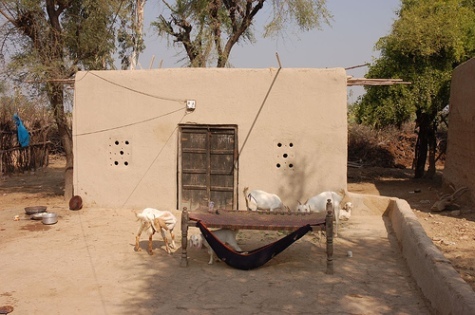
Architecture: Using Mud to Build Homes, written by S.A.J. Shirazi, is a short essay proclaiming “the future lies in mud architecture”, particularly in the authors home country of Pakistan.

Architecture, Design, and Culture using of mud, clay, soil, dirt & dust.

Architecture: Using Mud to Build Homes, written by S.A.J. Shirazi, is a short essay proclaiming “the future lies in mud architecture”, particularly in the authors home country of Pakistan.
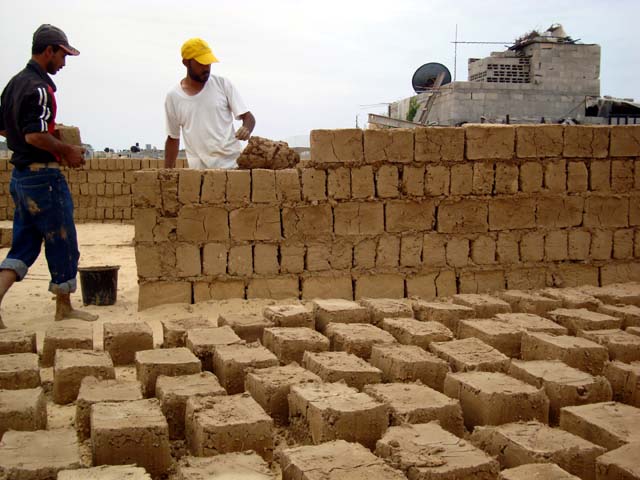
Building earthen structures like bread ovens and small animal pens is a technique many Palestinians are familiar with, but extending the method to houses isn’t a notion that has taken hold in Gaza. But Jihad el-Shaar, who lived with his wife and four daughters with extended family wanted to build a home of their own. After waiting for two years, it was apparent that the siege would make cement unavailable so he decided to build his house of mud.
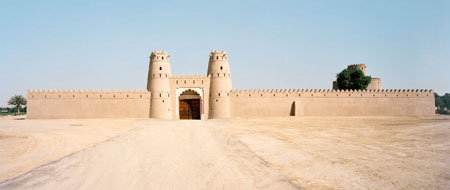
Historically, the daily life of the inhabitants of Al Ain, today the second largest city in the Emirate of Abu Dhabi, took place in the palm gardens of the oasis and the surrounding settlements and markets. To protect the oases, watchtowers and forts were erected. The Jahili Fort located in the modern-day centre of the city is the largest of Al Ain’s forts. Built in the 19th century by Sheikh Zayed the First, it can be seen from the Al Ain oasis to the west of the city. With its distinct three-tiered profile, the fort is now a national monument, pictured on the 50 Dirham note and often used as a logo or model for new architecture. The old fort was erected at the end of the 19th century.
The fort was recently restored by Roswag & Jankowski Architekten, Berlin.

The interior surfaces remain true to the historical appearance. The ceiling consists of palm rafters and palm leaves. A local clay plaster has been used for the interior wall surfaces. In the exhibition areas a grey coloured fine clay finishing plaster made by Claytec was used to create a neutral background for the exhibition spaces. The floors likewise follow historical precedence and are made of rammed earth stabilised with a wax to cope with greater wear and tear.
All new insertions such as doors and furniture, made of corian or wood composite, are coloured white differentiating them from the surrounding building. The external render of the existing walls was examined and repaired where necessary. Previous renovation works had employed a non-traditional plaster with added gypsum for the crenelations. This plaster is too rigid and already exhibited defects; it was replaced with a clay plaster. The building was then given an overall finishing coat of clay plaster. The earth plaster is maintained at regular intervals as is traditional with this historical material. When used as an external render, clay plaster should be regarded as a weathering surface that needs ongoing maintenance, typically every two years, sometimes after sustained periods of heavy rain. Sandstorms are also a cause of erosion.
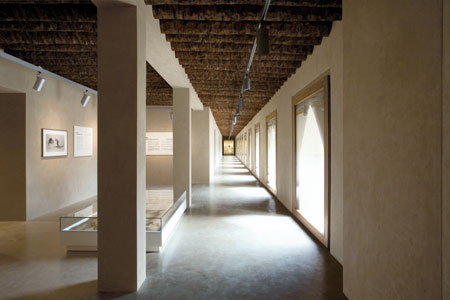
Most of the spaces will house a permanent exhibition “Mubarak bin London: Wilfried Thesiger and the Freedom of the Desert” showing photographs taken in the 1940s by the researcher and explorer Wilfried Thesiger who in the 1940s crossed the deserts of the Arabian peninsula repeatedly travelling with Bedouins and documenting what he saw with a Leica camera.
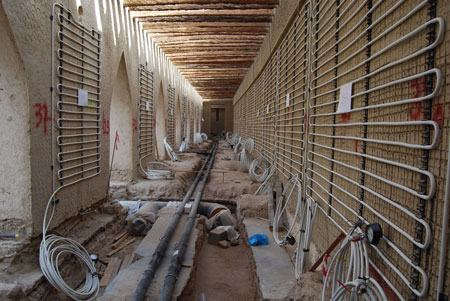
The 90 cm thick external earth walls offer excellent thermal insulation. The additional insulation on the roof improves still further the indoor room temperature and together with the solar protection windows on the façade provide effective protection against the extreme heat outdoors. The building is kept at a constant 24°C using a water-based cooling system integrated into the plaster layer of the walls. This minimizes the need for additional air cooling so that only fresh air is required. The cool indoor temperature of the walls and the reduced need for cold air makes the indoor climate more comfortable and reduces the energy consumption. An actual room temperature of 24°C equates to a felt room temperature of 22°C. The plant and technical installations for the entire fort are located below ground in the buffer zone.
The construction is made of traditionally available building materials including earth, palm products and to a lesser degree also timber. The quartered palm trunks can span a room of about 2.70 m and dictate the strongly partitioned structure of the historic buildings. The walls consist of air-dried earth blocks which can be built directly on the sandy ground without the need for foundations. A matting made of palm fronds covered with earth is laid on rafters made of split and quartered palm trunks arranged at an incline. The small amount of timber available was used for the door and window frames.
The Jahili Fort built in 1898 in Al Ain is now at the centre of an exciting conservation, restoration and development project that will preserve the values of this historic building whilst transforming the site into an active visitor destination.

The result of nearly two decades of research, The Architecture of Yemen: From Yafi to Hadramut the first book to offer an in-depth investigation into the characteristic architecture of the southern and eastern towns of Yemen, which until the early 1990s were extremely difficult of access. The author’s first-hand research provides detailed insights into building design, techniques and methods that, though rich in tradition and accomplishment, are little known outside the region.
Refreshingly, the book moves out of the more familiar major cities into the hinterlands and explores areas that could be said to be the last strongholds of vernacular Arab architecture. The author, Salma Samar Damluji, was allowed to visit locations and sites previously closed or unfamiliar to architects and foreigners. As a result of this privileged access, the text and images combine to convey unique insights and viewpoints: those of the master builders and house owners who actually create and inhabit the buildings. In addition to approximately 700 colour images and architectural drawings, a unique glossary of over 900 terms complements the text.
Save the Heritage of Hassan Fathy is an International Association based in Geneva (Switzerland), founded in February 2008 to safeguard the heritage of the Egyptian architect, Hassan Fathy.
His works constitute a patrimony of outstanding value which belongs to the cultural world heritage. The Association’s objectives are the following:

French archaeologists have discovered an 11,000-year-old work of art in northern Syria which is the oldest known wall painting, even though it looks like a work by a modernist. Rectangles dominate the ancient painting, which formed part of an adobe circular wall of a large mud brick house with a wooden roof. The dating makes the designs at least 1500 years older than wall paintings at Çatalhöyük, the famous 9500-year-old Turkish village, among one of the first towns.

Shibam, Yemen, also known as ‘the manhattan of the desert’, is home to the world’s oldest surviving skyscrapers.